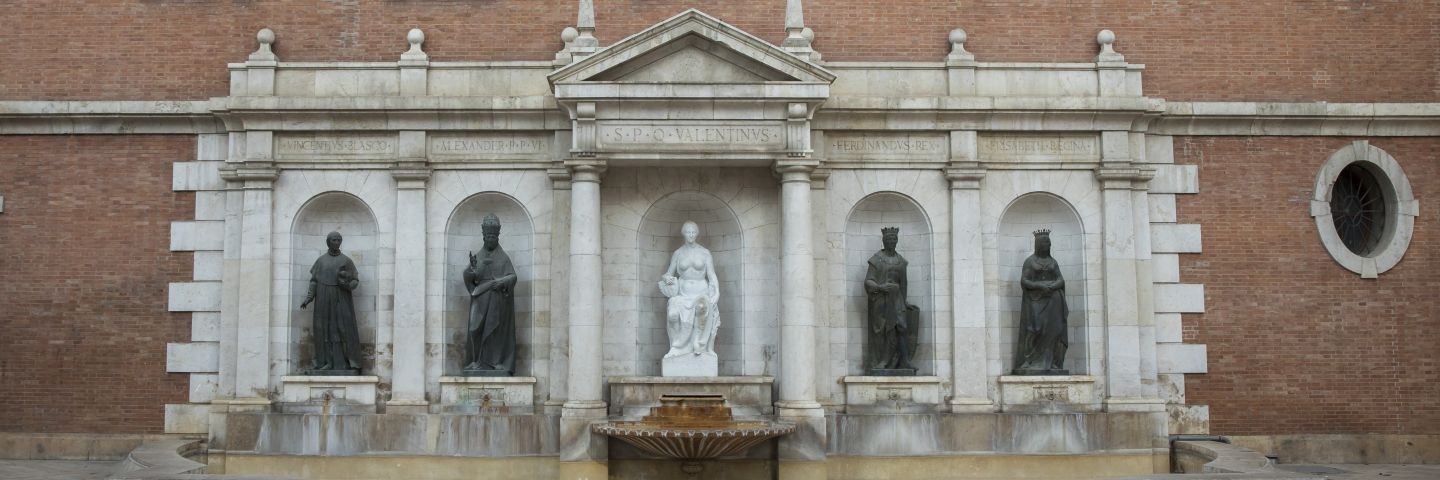The sculpture which dates from 1975 and faithfully responds to the style that the sculptor developed during the seventies based on the structure of the generriu, which consists of series of multiple rods or tubes of stainless steel or aluminum unfolded as in complex three-dimensional fans, in a theoretically abstract geometric form, but almost always alluding to concepts or experiences, to indeterminate figures characterized by their ability to transform themselves radically depending on the point of view and light. The name that the author gives to this sculpture is “Circling it“.
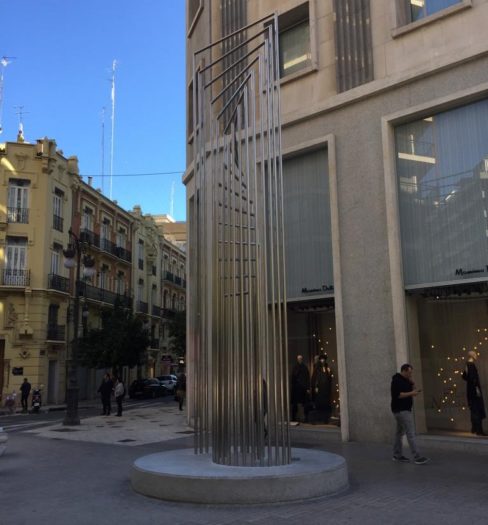
The sculpture is made of stainless steel 308 and has a rectangular shape, with dimensions of 2.00 m x 1.30 m, and a height of 7.50 m. The base fixing structure of the sculpture is rectangular with dimensions of 3.02 m x 2.28 m, and a height of 0.31 m.
The weight of the base is 120 kg and that of the sculpture is 398 kg, with the total weight being 518 kg.
The author of the sculpture is Andrés Alfaro.

On a high stone pedestal, surrounded by a landscaped space, at the beginning of Gran Via de Ramón y Cajal, next to the so-called Plaza de España, in front of the old “hermitage” of La Roqueta, today a parish church, just away from the spare monument to San Vicente Mártir, this other del Cid Campeador, work of the American sculptor Anna Hyatt Hungtinton, widow of the great Hispanist Archer Milton Hungtinton, having that artist, participated in the love in Spain of her husband, also given the expensive casting of the equestrian statue, worth about three million pesetas. The work is an exact version, fused by the sculptor Joan d’Avalos, of the one before the Hispanic Society of New York founded by Mister Hungtinton, the translator of the Poem del Cid, friend of Sorolla, whom he commissioned the immortal series of the Spanish regions and creator of a wonderful Museum in the vicinity of the turbulent New York Harlem of which it is admirable counterpoint. The statue arrived in Valencia on March 3, 1964. This put an end to a series of attempts, which, as in the cases of Sorolla, Serrano and Llorente, were vain or very late, since already in 1888 they were formulated in favor of a monumental memory of Valencia, to the Castilian leader who made it -with the Aragonese San Vicente martyr- famous in the world, proliferating memories of El Cid in literature, and to the Holy Levite Huesca in the immortal poetry of the Peristephanon.

In the triangular square, without specific name formed by the streets of Escultor José Capuz and Oriente, this monument is located in honor of the very remarkable plastic artist José Capuz Mamano, son of Valencia, Academician of the Royal Saints of San Fernando and San Carlos, professor at the School of Fine Arts of Madrid and Valencia and author of numerous and inspiring works.
It is composed of a shallow rectangular laundry, with a bronze statue of a boy with pigeons between his hands and chest, at an angle of the laundry, the work of Capuz, as well as a large rectangular block of country stone, earthy color, with a high relief creation of the master, with the sign corresponding to his subject the “Fisherwoman” and on the other side, the inscription “Valencia to José Capuz” with the coat of arms of the City and a self-portrait relief of the artist, which is part of his bust -existing in the Museum of Fine Arts of Valencia -work of the also Valencian sculptor Francisco Marco Díaz-Pintado, the signature of the “F. Marco” and date “1935” are incised on the edge of the portrait.
The monument, in its material brevity, has a very worthy aesthetic category for the figure it commemorates, and the signatures of the two artists that appear in it, both Capuz and Marco Díaz-Pintato, as well as for the beauty of the “Pescadora”, a strong and expressive work, of classical solidity and insinuating noucentista modernism, characteristic of the master to whose memory he contributes.

Monument in honor of the excellent Xàtiví artist, established in Naples, José de Ribera called the Spagnoletto. A particular initiative of Aurelio Querol who, approaching the date of the third centenary of the birth of the great painter (1888), summoned Valencian artists on January 24, 1886 to the Athenaeum to raise funds with which to make the well-deserved monument. Gathered and exhibited some seventy pieces, painting and sculpture, their sale provided resources with which to undertake the work.
The monument was commissioned to be made to Mariano Benlliure, who was only 23 years old, did not want to perceive anything to model, demanding only that the bronze be melted in Rome and under his personal surveillance. Ribera, represented in a natural attitude, stands backwards with the palette in one hand and the brush in the other, nor does he lack his cloak, nor at his waist, the chivalric sword.
The pedestal, made of Carrara marble, with an octagon floor plan with alternately unequal sides, has, on its wide sides, the coats of arms of Valencia, Xàtiva and the Royal Academy of San Carlos amparadora with the Town Hall of the homage. In front of the figure, there is a label with a laurel wreath surrounding the description: “A Ribera”.

The motive that drives us to make this sculpture and donate it to the city is to make visible the cruelty of the abandonment of pets and the suffering that causes them, raising awareness in society about this problem that affects them all. It is also a tribute to the people who care for the animals that others abandoned.
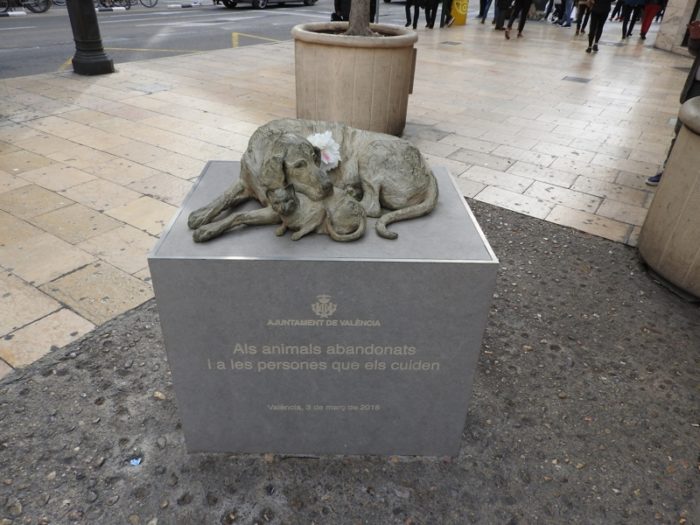
It measures 90x70x30 cm and weighs 70 kg. The piece is on a base covered with ceramic with the front engraving of a dedication on behalf of the city of Valencia and headed with the municipal coat of arms and on the side is engraved the poem ‘de carrer’ by the same author.
On a large cubic pedestal we find the figures of two animals in a seated position and huddled together, a dog and a cat. The dog is named Tristán and the cat Soledad. These are figures cast in bronze with a patina that simulates the sculpture in stone. The work has been donated by the sculptor Elena Negueroles Colomer (Alzira-Valencia 1949) to the Valencia City Council. The sculptural group was inaugurated on March 4, 2018 and has the artist’s signature engraved on one of the dog’s legs.
With this slogan, constant in its smooth pedestal, it will rise at the meeting of the streets of Roís de Corella and Sant Vicent Màrtir, an unusual monument, which is so, not only because of its forms, close to expressive surrealism, but also because of its origin: the donation, not without some patronage, of a commercial house (John Deere) whose advertising motivation there is hardly any record in any less visible side of the work, which is not the only one coming from this origin, because there are others, different, in various Spanish towns.

His trilemma is reflected in three figures, man, woman, child, stylized in the synthetic, curvilinear, and expressive, which has the volumenic effectiveness of the voids; being the work of José Carrilero Gil, Caravaqueño artist, cast by E. Capa, both from the School of Fine Arts of Madrid.
The monument, which with some others, recent, represents in our street art, the most modern trends, was inaugurated by Mayor López Rosat on March 15, 1972.

The monument to the Valencian farmer is located on Gran Via del Marqués del Turia, from its intersection with Ruzafa and connects with the Germanies. It has been located at the other end of the monument to the Marquis of Campo in Plaza de Cánovas since August 3, 1931.
It consists of the figure of a farmer, the work of Carmelo Vicent, with allegories and ornaments on its flanks and a small laundry – the monument is not large. The material is country stone and the careful and sober ploughing, unrealistic or constumbrist or folkloric, that the subject imposes.
On the front side is inscribed “The City of Valencia, in the Valencian farmer”. And in the later, facing the Gran Via gardens, the verses of Teodor Llorente in “La Barraca”, on one side.
“… Sober, suffering, Light, strong and Loyal
what to the rough Fallow nails the rella,
and OPEN to water Stream deep channel … “
And on the other side, Blasco Ibáñez’s lines:
“When the whole orchard was still sleeping, it was already in the indecisive light of dawn, scratching its beloved lands.”
Below the statue and above the losange of Valencia, without a crown is inscribed “YEAR 1931”.
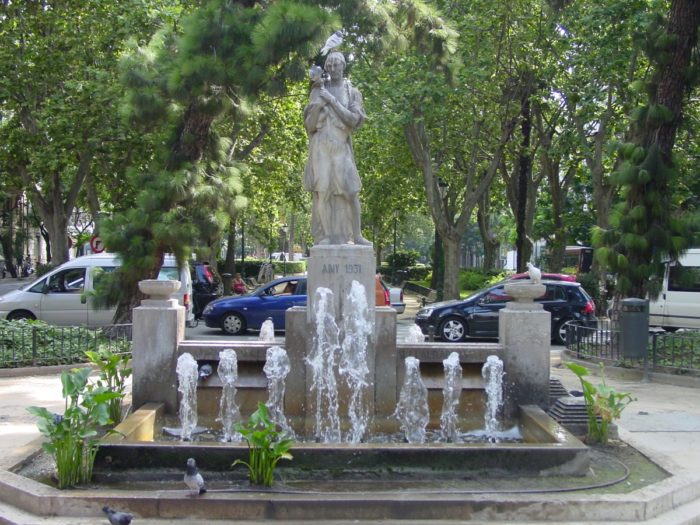
After the restoration of the cloister of the College of the Patriarch was carried out between 1943-1944 by the architect Javier Goerlich León, in 1964 S. Octavio Vicente was commissioned to design the sculptural decoration of the façade overlooking Plaza del Patriarca.
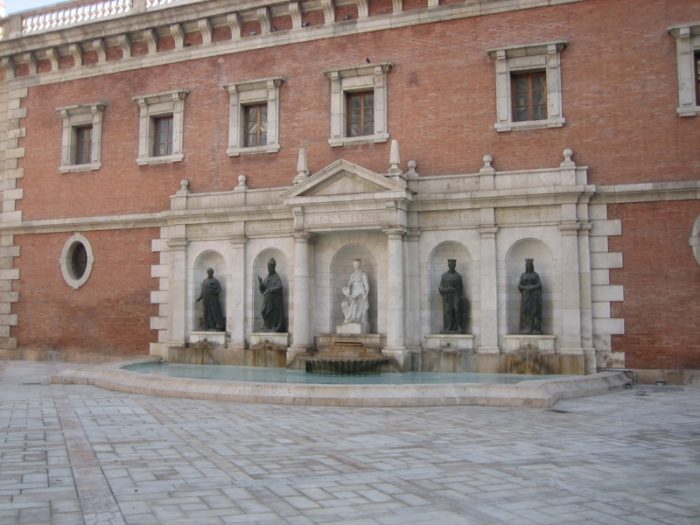
Placing in the predetermined space for 4 niches, the bronze statues representing the Catholic Monarchs, Pope Alexander VI and Rector Blasco. In the center of the group was placed an allegorical figure of Wisdom, made of white marble.
Apollo was considered the son of Zeus and Leto. In the Homeric dedication he was above all god of prophecy, his most important oracle being at Delphi, where he emerged victorious from the battle against Python. He used to bestow the gift of prophecy on those mortals he considered gifted musicians who delighted the gods by playing the lyre, he was also a good archer and fast athlete, credited with having been the winner of the Olympic games. His sister Artemis was the guardian of women while Apollo protected men in a special way. He was also God of agriculture and beasts, and taught humans the art of medicine.
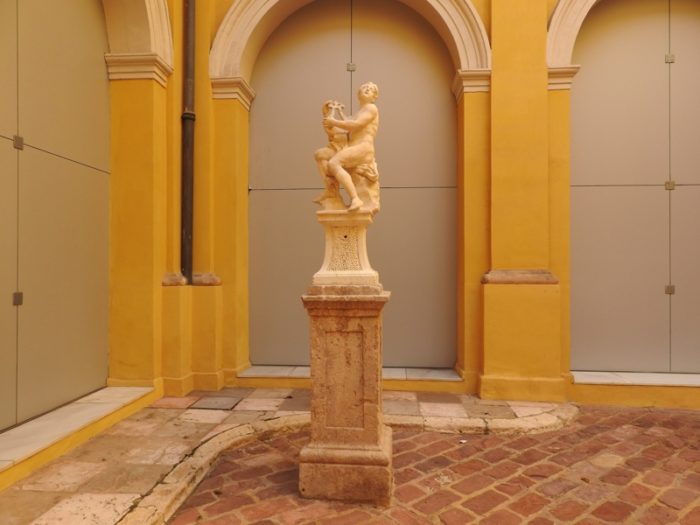
The statue is made of marble by Ponzanelli in the eighteenth century. At first it was placed in La Glorieta in 1818 from the Huerto de Pontons to pass in 1925 to Jardins del Real and finally it was moved a few years ago to the courtyard of the City Museum.

The ensemble, arranged in a circle, is an association of Llorentino motifs – dulzainero, tamborilero, Faust and Margarita and an allegorical nude of Poetry – the scene culminates with the decoration of Llorente for Valencia. It was restored in 2003.
At the junction of the Gran Via par excellence -that of the Marqués del Turia- with the streets of Pizarro and Taquigrafo Martí rises since August 4, 1913, this commemorative monument has been inspired by the poet, in Valencian and Spanish, historian, journalist and public man, Teodor Llorente Olivares, on the initiative of Peris Mencheta, supported by distinguished personalities of the culture.
Through a previous competition and subscription, it was awarded to the project of the architect Dicenta and the Valencian sculptor Gabriel Borràs, son of the painter Vicente Borrás Abella.
The whole, arranged in a circle suitable to be seen from four sides and still from all possible points of view, is an association of Llorentino motifs – dulzainero, timbaler, Fausto and Margarita (as translator of foreign poets) the girl with the honey jug, the last gift made to the poet and an allegorical nude of poetry – culminated by the scene of the coronation of Llorente by Valencia, evoking the effective imposition of the silver crown, shaped like laurel branches, which the poet had previously objected to, during the Regional Exposition.
Monument located on the Gran Via de Fernando el Católico, work of Vicente Navarro Romero, who died in 1978, but already in 1908 won the prize with the bust Giner, after being many years in the Plaza del Arqueobispo, this seated monument, with classical tunic, inspired by the composer Salvador Giner i Vidal (1832-1911) that had been inaugurated on May 22, 1921 in the Glorieta, with the assistance of Vicente Blasco Ibáñez; in 1943 it moved to the aforementioned Plaça de l’Arquebisbe and, since 1960, to Gran Via where it is located now, closer to the El Micalet Choral Society, so closely linked to the maestro, the founder, that every year on the Second Sunday of November it receives the tribute of this Society and other entities and bands, plus enthusiasts and admirers, after saying the officiated Mass in the neighboring parish of El Pilar. The idea of the monument to Master Giner germinated the day after his burial.
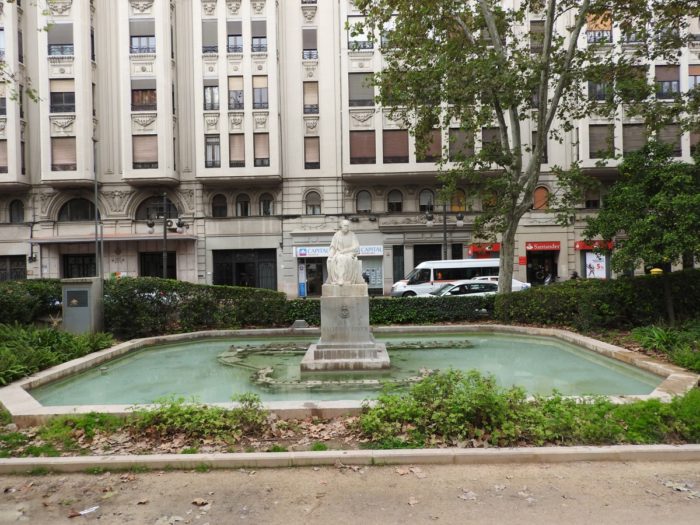
Constituted by a symbolic female statue dressed in broad robe that holds with the left hand and on the ground a shield bearing the emblems of the Economic Society of the Country (hive with bees…) and the motto “Friendship-Fatherland”.
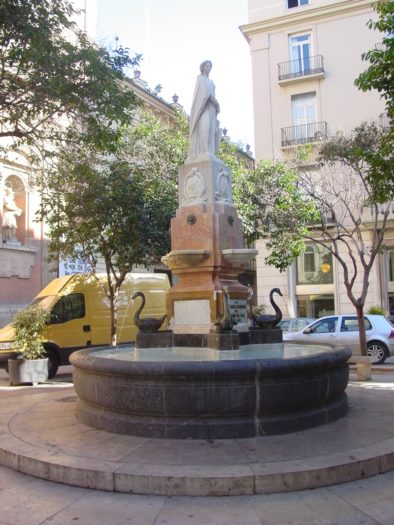
On the sides of the pedestal there are stone shields, with allegories of Commerce, Navigation, Sciences and Arts.
The author of the statue is Antonio Marzo.











